William C. C. Chen's Applications Videos
Martial Arts Applications of Tai Chi Chuan
Channel:
Essential Sports and Fitness Videos (Tai Chi)
These videos of Grandmaster Chen offer glimpses into his specialty,
teaching the connection between the Tai Chi movements, push hands, and achieving great speed and power for self defense.
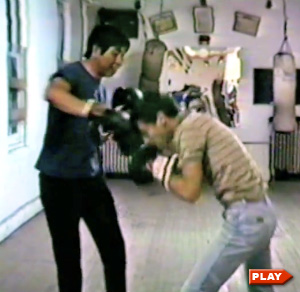
Private Boxing Lesson
Relaxed, smooth use of the body. (00:12:29)
A rare video of Grandmaster Chen sparring with one of his students, showing how Tai Chi softness, smoothness, and relaxation
can be effectively applied to boxing. (NYC, late 1970's or early 1980's)
His training technique emphasizes light, relaxed, slipping of punches and fast counter-punching,
as opposed to blocking and throwing powerhouse shots. To succeed at relaxation and maintaining a light touch, he would often leave himself open
to being hit and encouraged his students to do the same. (VHS tape)
From: William C. C. Chen
To watch Grandmaster Chen's boxing lesson, click on picture
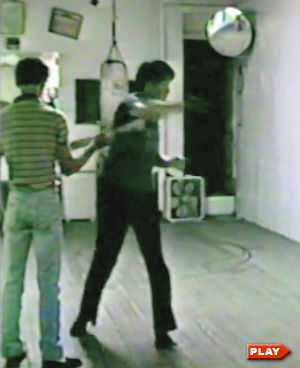
Double Punch Lesson
Achieving speed and power. (00:04:42)
We see Grandmaster Chen teaching one of his favorites, a double right-cross. The first punch is a fake to the belly, followed
by a fast, powerful punch to the head. (NYC, late 1970's or early 1980's)
He uses a rolled-up newspaper as the target and shows how to move from the bottom to the top of the roll
with amazing speed and power. (VHS tape)
From: William C. C. Chen
To watch Grandmaster Chen's boxing lesson, click on picture

Boxing Class (2002)
Basic punches, blocks, and combinations with the Tai Chi feeling. (00:10:37)
This episode of Sam Masich's Taiji People series follows Master Chen through a boxing class, with plenty of examples
of his punching speed and power.
He demonstrates the connection between Tai Chi principles and basic punch and blocking combinations.
Power comes from the base, not the arms. The body stays loose, without tension.
We see him giving instruction to his children, martial arts champions, Tiffany and Max, as well as U.S. and world push hands champion, Josh Waitzkin.
From: William C. C. Chen and Sam Masich
To watch Grandmaster Chen's boxing lesson, click on picture

Television Demo of Tai Chi Principles and Punches
What's the difference between Tai Chi for exercise and Tai Chi Chuan? (00:10:42)
We see a short clip of Michelle Obama doing Tai Chi in China, and then Grandmaster William C. C. Chen discusses
the principles of relaxation, flow, and energizing the fingers in the Tai Chi form.
The interview gets pretty hilarious as he shows that Tai Chi is more than a health exercize and is a practical
martial art.
He explains that avoiding muscular tension leads to great speed and demonstrates by holding a banana
that the fist does not need to be clenched to deliver an effective punch. (Recorded 2014-03-27.)
From: William C. C. Chen and Arise TV (00:10:42)
To watch Grandmaster Chen's interview, click on picture

Martial Arts: The Real Story - Tai Chi Chuan with William Chen
The relationship between Tai Chi, relaxation, mechanics, and fighting. (00:02:24)
Grandmaster William C. C. Chen talks about his teacher, Cheng Man Ching, and explains and shows how the principles
of Tai Chi apply to fighting.
His son, Max, and daughter, Tiffany, both of whom are champion martial artists themselves, help Master Chen demonstrate
boxing, kicking, and push hands.
Pacific Street Films (DVD)
To watch William Chen and all the other masters in "Martial Arts: The Real Story", click on picture
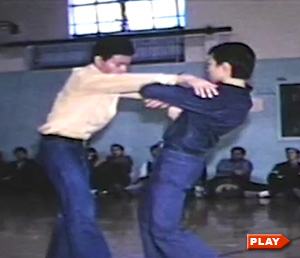
Tai Chi Workshop and Demos from the 1970's
Rare clips of demonstrations showing martial arts applications. (00:02:02)
Grandmaster Chen and his senior students show the usefulness of moves, strikes, and kicks derived from the Tai Chi form.
This video starts out with some push hands demos, including the use of shoulder strike from the Tai Chi form,
with the audience participating.
The main focus of this video is demonstrations by Grandmaster Chen's students of the martial arts applications derived from the Tai Chi form.
(8mm, no sound)
From: William C. C. Chen
To watch this Tai Chi demo, click on picture
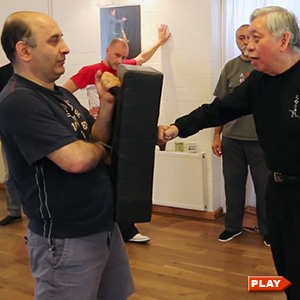
Tai Chi Worshop in Hanover 2014-06
"From something to nothing. From nothing to something." (00:05:03)
Grandmaster Chen explains that the fingers are the key to action
and describes the energetic connection between the fingers, the heart, and the toes.
He shows how power and speed come from the combination of spiralling from the ground and floating from the ribs.
Finally, he demonstrates with a few practical self-defense applications how the relaxation and focus of the Tai Chi form lead to the
flexibility to strike from any position.
From: William C. C. Chen and Nils Klug
To watch this clip of William Chen in action, click on picture
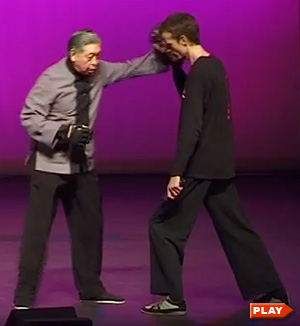
Form and Application Demo
Tai Chi Chuan as self-defense. Cheng Man-Ching Forum 2004. (00:08:08)
Grandmaster Chen and Sifu Nils Klug go through the first portion of the Yang Short Form (with a nice Sitar background).
Then Grandmaster Chen explains the relationship between slow, calm movements and martial arts.
Then he shows how speeding up particular moves of the Tai Chi form leads to an effective jab, cross, hook, roundhouse,
and uppercut.
From: William C. C. Chen and Nils Klug
To watch this clip of William Chen in action, click on picture
Grandmaster Chen on "fighting art training" (2016)
|
The unhurried slow motion of Yang Style T’ai Chi Ch’uan is the best way of learning process.
It is like a beginning typist who practices slowly and properly.
That promotes our physical relaxation and mindfulness to direct the human motion energy qi for action.
The natural internal action is coming from the energy qi flow that is stimulated by the mind and then the physical body follows.
Qi energy is an expandable outgoing energy.
The muscle is a contracting force to sustain the resistance.
The slow T’ai Chi Ch’uan movements triggers the qi flow into fingers that moves the palm out to float into the air.
In rapid action, the qi explodes like ammunition and discharges the fingers to deliver knuckles for punch
and without activating or tensing the muscles.
The free and frictionless arm muscles escalate additional speed and increases power.
When I apply ‘Tai Chi Ch’uan as a fighting art, I work on a few moves at one time.
The simpler the moves that I train the easier it is for me to perfect them.
The slow motion with relaxation helps to prevent the muscle contraction and is essential to my learning process.
After my daily T’ai Chi Ch’uan practice, I brake the movements down into an individual movement or moves to practice as a fighting art.
I repeat them training 200 to 500 times in slow motion and with full awareness.
It helps me customize the internal motion in action.
Practicing in this manner, it took me nearly a year to complete Prof. Cheng’s 37 posture short form.
Then I chose a few of the most practical fighting techniques or movements.
I practiced in slow motion and speeded up afterwards.
Once I had repeated each technique 5,000 times or more,
I could execute these techniques at a satisfactory level in slow motion as well as at full speed.
This was done until they matured before moving on to the next movement.
|
|
In 1950 I was assigned to assist in Prof. Cheng’s internal training.
This is training the body to absorb punches and kicks.
During the second year, I followed the formula to train myself in my leisure time.
After training an hour a day, in less than a year I found my body was able to take punches and kicks.
This was of enormous help to my free-fighting practice, which benefits me in sparring without fear of getting hurt,
I could concentrate on good techniques as well as better coordination.
This added to my enjoyment in the art of free fighting.
Living in Prof. Cheng’s house was a priceless opportunity to obtain the right information for correct training.
Even the few of us who were close disciples of Prof. Cheng had little chance to see him practice the entire T’ai Chi Ch’uan form.
However, we often saw him work on a few movements here and there.
He never directly instructed me to train in this manner.
But having gathered such valuable information this way,
it appears to me that concentrating on a few functional and realistic fighting techniques in slow motion
is the best way to achieve my fighting capabilities.
There are many martial artists who have studied either soft styles or hard styles for many years without achieving real self-defense capability.
Perhaps due to their impatient nature, or they wanted to practice too many techniques and to have quick results.
A famous phrase “Jack of all trades, master of none”.
To focus exclusively on a few fighting techniques at a time is the best way to learn the fighting art of T’ai Chi Ch’uan.
The fewer techniques that I try to learn, the more I can accomplish and the easier it is to perfect them.
Practicing a few movements at a time in slow motion and keeping my muscles relaxed, were essential to my learning process.
|